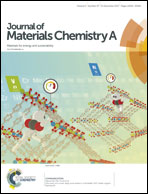Tailoring pore structures to improve the permselectivity of organosilica membranes by tuning calcination parameters†
Abstract
Although microporous organosilica membranes have proven their excellent hydrothermal stability and permeability in H2/CO2 separation, it is still challenging to meet the permselectivity requirements of industrial applications. In this work, microstructures of 1,2-bis(triethoxysilyl)ethane (BTESE)-derived organosilica membranes were tailored through the tuning of calcination parameters including calcination temperature (Tc), heating rate (r) and dwelling time (t). A series of organosilica powders were prepared to optimize the calcination conditions for fabricating BTESE-derived organosilica membranes with excellent H2/CO2 separation performance. It is found that the organic bridge groups in organosilica networks are sensitive to calcination conditions. The organosilica membranes calcined at 600 °C with an expeditious calcination (r = 10 °C min−1, t = 5 min) show a high cross-linking degree in their network and contain a high content of organic bridge groups. This expeditious calcination enables organosilica membranes to have a H2 permeance of 4.61 × 10−8 mol m−2 s−1 Pa−1 and a H2/CO2 permselectivity of 17.5. The organosilica membrane calcined at 600 °C with a slow calcination has a high H2/CO2 permselectivity of 36.4. The mechanisms of using expeditious or slow calcinations for developing organosilica membranes with outstanding separation performance are further confirmed, which may offer a novel method for preparing desirable organosilica membranes.



 Please wait while we load your content...
Please wait while we load your content...